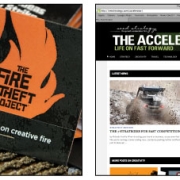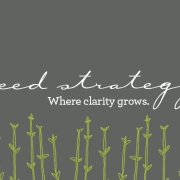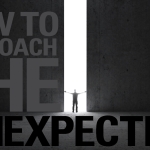Less Churn, More Burn: 4 Ways to Master Ambiguity and Keep Projects Moving Fast
Mastering ambiguity, or being able to find a solution when a solution isn’t clear, is key to accelerating growth for your brand and career. Seed’s VP of Strategy, Kevin Namaky, shares four ways you can get the ball rolling when direction is lacking.
Have you ever had one of those moments where it’s just not clear what to do next? Perhaps too many options or too much information is staring you in the face. You’re not sure how to sift through it. Or maybe you don’t have enough information. A blank canvas, white page or white board is looking right at you, but you aren’t sure how to start…
There are a number of situations like those mentioned above where you might be faced with ambiguity. It happens all the time when dealing with:
- How to solve a specific problem
- How to tell a story, convince someone or gain alignment
- How to choose between strategic alternatives
- How to build a project plan or process
So, how do you accelerate progress when direction is lacking? Whether you are faced with incomplete information, too much information or there is no perfect answer for these situations (ambiguous, by definition), here are four techniques that can help you narrow down your options and get further, faster.
1. Ask yourself, what’s the objective? Too often it’s easy to get caught up in tactics. The risk with this is that it can clutter thinking and get in the way of what really matters. Brainstorming ideas and solutions has its place, but oftentimes the tactics become so overpowering that we can lose sight of the objective.
Ask yourself: what’s the ONE THING that must be accomplished when it’s all said and done? For presentations, what’s the ONE THING that the audience must remember when they walk away? Filter ALL of your effort and information through that lens and, if it doesn’t support the main objective, take it out of the “ambiguous mix.” This can also help determine which suggestions from others are truly helpful and which unnecessarily muddy the waters.
2. Write a brief… to yourself. Would you ever ask an ad agency to develop a new ad campaign without first aligning on a creative brief? Don’t answer that. Writing a creative brief to yourself can be a really helpful and revealing exercise. This works for projects as well as specific deliverables (e.g., presentations) and it goes beyond the question of “what’s your objective” to help you identify what you know and what information or inputs you need to know. The exact elements of your brief might vary depending on the situation, but below are some things you could start with:
- Background (keep it short, high level)
- Objective / Core Challenge (only list one if you can, be specific)
- Deliverables (be specific, this is usually something very tangible)
- Target Audience (who the deliverable is targeted towards)
- Budget and Timing (related to the Objective / Core Challenge)
- Key Insight or Existing Resources (to draw from, inform the work)
- Mandatories and/or Guardrails (mission critical only, not a laundry list of nice-to-haves)
- Thought Starters (optional but could give you a chance to jot down initial thoughts, sketches or an outline as a starting point)
This exercise puts you in better position to determine potential (and best potential) solutions.
3. Break it down. Breaking the core question or challenge down into component questions is great for identifying and sequencing steps (i.e., building a process). What questions do you need to answer in order to meet the challenge? Make a list. For example, if your core challenge is to come up with a new, breakthrough product idea, your list of component questions might include:
- What relevant customer/consumer needs aren’t met by current market offerings?
- Based on the unmet needs you’ve identified, what is the range of possible ideas that could be pursued?
- How might these ideas be designed or articulated?
- Which ideas resonate most with your customer/consumer base? Can you quantify this?
Go back and filter your questions with the following test: Which of these questions are not absolutely mission critical? Eliminate the ones that are “nice to have.” Next, consider sequencing. Which questions are dependent on the answers to other questions? Put them in the order they need to be answered (i.e., the answer to one question may serve as a key input for answering a later question). Pat yourself on the back – you now have the bones of a project plan! Now that you know the questions to go answer, you can start to think more specifically about how to answer them.
4. Hypothesize. Put a stake in the ground as a starting point, knowing that it might evolve as you go. This technique is especially helpful when you have too many options or answers. Note that hypothesizing is not the same as guessing – hypotheses use all of the best information you have available to create a logical starting point (or answer) to work from. You may have more than one, that’s ok. You don’t have to test EVERY scenario (think proxies). Pick a few that could likely be correct (or a representative few that have a good chance). Now you can think about how you would gather insights or test the few lead hypotheses you have. Your learning may eliminate some hypotheses while building on and refining others. In some cases, you may even be able to run with just a single hypothesis you feel strongly about and adjust as you gain additional insight. The key is not to be paralyzed by options, but to use a smaller number of hypotheses to move forward and set a foundation.
Not every technique applies to every situation; feel free to pick and choose which ones make the most sense for the task at hand. No matter what you decide on, having these four techniques at the ready will help you establish direction, accelerate forward progress and master ambiguity. Now… get going!
P.S. Follow Seed Strategy on our LinkedIn, Twitter, Facebook and Instagram pages










Trackbacks & Pingbacks
[…] 5. Less Churn, More Burn: 4 Ways to Master Ambiguity and Keep Projects Moving Fast […]
Comments are closed.